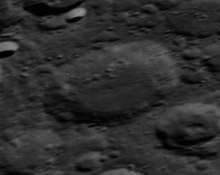Polzunov (crater)
Polzunov is a lunar impact crater that is located just to the south-southeast of the larger crater Seyfert, on the far side of the Moon. It was named after Russian heat engineer Ivan I. Polzunov.[1] About one crater diameter to the west-southwest lies Deutsch, and somewhat farther to the south-southeast is Olcott.
 Oblique Apollo 16 image, facing northwest | |
| Coordinates | 25.3°S 114.6°E |
|---|---|
| Diameter | 67 km |
| Depth | Unknown |
| Colongitude | 246° at sunrise |
| Eponym | Ivan I. Polzunov |


This crater has a worn and eroded outer rim, although it is marked only by a few small craterlets. Along the southwestern exterior is the satellite crater Polzunov N, a relatively fresh crater with a prominent central peak. The interior of Polzunov is marked only by an uneven region near the northern end of the crater. There is no central peak to speak of, and the remainder of the floor is relatively level and marked only by a few tiny craterlets.
Satellite craters
By convention these features are identified on lunar maps by placing the letter on the side of the crater midpoint that is closest to Polzunov.
| Polzunov | Latitude | Longitude | Diameter |
|---|---|---|---|
| J | 23.6° N | 117.4° E | 30 km |
| N | 23.7° N | 113.8° E | 35 km |
References
- "Polzunov (crater)". Gazetteer of Planetary Nomenclature. USGS Astrogeology Research Program.
- Andersson, L. E.; Whitaker, E. A. (1982). NASA Catalogue of Lunar Nomenclature. NASA RP-1097.CS1 maint: ref=harv (link)
- Bussey, B.; Spudis, P. (2004). The Clementine Atlas of the Moon. New York: Cambridge University Press. ISBN 978-0-521-81528-4.CS1 maint: ref=harv (link)
- Cocks, Elijah E.; Cocks, Josiah C. (1995). Who's Who on the Moon: A Biographical Dictionary of Lunar Nomenclature. Tudor Publishers. ISBN 978-0-936389-27-1.CS1 maint: ref=harv (link)
- McDowell, Jonathan (July 15, 2007). "Lunar Nomenclature". Jonathan's Space Report. Retrieved 2007-10-24.CS1 maint: ref=harv (link)
- Menzel, D. H.; Minnaert, M.; Levin, B.; Dollfus, A.; Bell, B. (1971). "Report on Lunar Nomenclature by the Working Group of Commission 17 of the IAU". Space Science Reviews. 12 (2): 136–186. Bibcode:1971SSRv...12..136M. doi:10.1007/BF00171763.CS1 maint: ref=harv (link)
- Moore, Patrick (2001). On the Moon. Sterling Publishing Co. ISBN 978-0-304-35469-6.CS1 maint: ref=harv (link)
- Price, Fred W. (1988). The Moon Observer's Handbook. Cambridge University Press. ISBN 978-0-521-33500-3.CS1 maint: ref=harv (link)
- Rükl, Antonín (1990). Atlas of the Moon. Kalmbach Books. ISBN 978-0-913135-17-4.CS1 maint: ref=harv (link)
- Webb, Rev. T. W. (1962). Celestial Objects for Common Telescopes (6th revised ed.). Dover. ISBN 978-0-486-20917-3.CS1 maint: ref=harv (link)
- Whitaker, Ewen A. (1999). Mapping and Naming the Moon. Cambridge University Press. ISBN 978-0-521-62248-6.CS1 maint: ref=harv (link)
- Wlasuk, Peter T. (2000). Observing the Moon. Springer. ISBN 978-1-85233-193-1.CS1 maint: ref=harv (link)